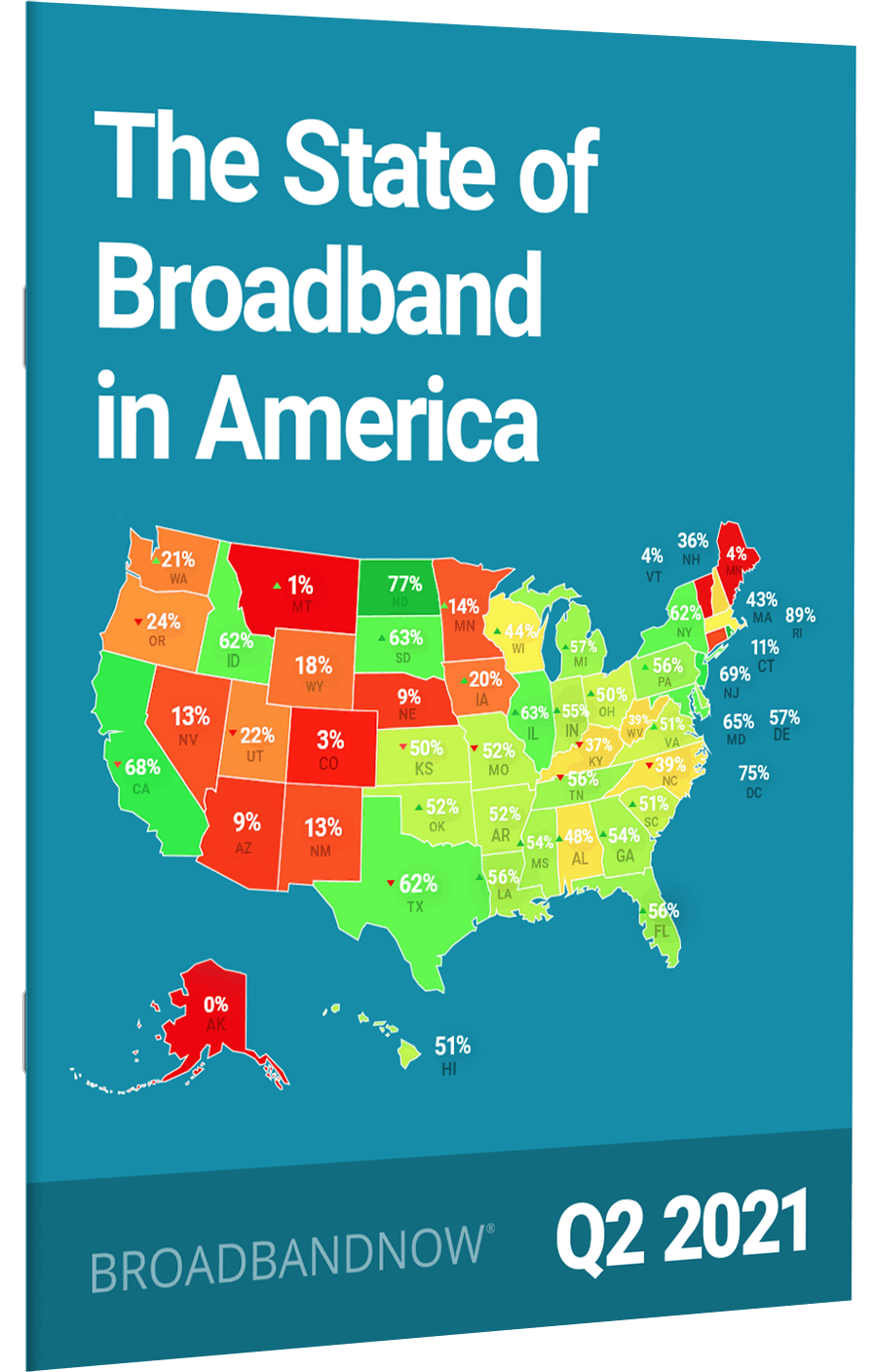Our second state of broadband report for 2021 arrives at a crucial turning point for internet proliferation in the United States.
Key Findings
- The trend of increasing access to low-priced plans continued in Q2 with 87% of Americans now having access to affordable wired broadband, the highest rate we have ever reported.
- Faster plans in the 100/25 speed group are also getting more affordable: 40% of Americans have access to an affordable wired plan at that speed.
- 43% of Americans have access to symmetrical service of 100 mbps download and 100 mbps upload speed from a wired or fixed wireless provider, up 6% from the first quarter.
Low-Priced Broadband Plans Expanded in Q2
As in our prior quarterly releases, the data for this report comes from (a) pricing and package data from all 2,000+ U.S. ISPs, (b) publicly available FCC “Form 477” data, (of which the latest public release was December 2020) and (c) updated coverage data voluntarily submitted to us directly from providers.
87% of Americans now have access to low-priced internet at speeds of 25 mbps download / 3 mbps upload. This is a significant uptick up from the 77% of Americans from our Q1, 2020 report and a massive 71% increase from 51% of Americans in Q2 of 2020.
A significant drop off remains from access to faster broadband plans in the $60/month or less range for the regular monthly (non-promotional) price. Faster broadband speeds, such as 100 mbps download / 25 upload, are priced significantly higher and only 34% of Americans have access to low-priced plans at these speeds. That said, 34% is 11% growth from Q1 so we are seeing this access metric improve as well.
Seeking Broadband Symmetry
As in our Q1 report, we have again highlighted broadband symmetry, which means both upload and download speeds are the same. Because real-world users are often in households with multiple internet users and needing performative upload and download speeds for video conferencing and online education, symmetry is a way to ensure that work from home is productive.
Upload speed, although not always advertised or focused on, is crucial in sending and sharing files across networks. We specifically looked at 100/100 and compared it to our higher broadband standard of 100/25 to measure the gap specifically in upload speed access. We are happy to report that the number of Americans with access to 100/100 speed from a wired provider increased in Q2 compared to Q1, up to 40% from 38%, which was a 6% improvement.
Speed Tests over Time
Download & Upload
Download and upload speed are the key performance indicators that are reported and advertised by ISPs. Network performance can vary from location to location so it is helpful to be able to compare states. The below tool allows you to select states from the dropdown menu and compare their median download and upload speeds over time.
Latency and RTT (Round Trip Time)
Second Quarter Industry Recap
All eyes were on the federal government this quarter as it prepared a historic spending bill in the wake of the Covid-19 pandemic.
Biden’s Broadband Bill takes shape
With a tentative agreement being reached on the Biden administration’s $1 trillion infrastructure bill, broadband is in the limelight in an unparalleled fashion. The bill includes $65 billion in spending for broadband, much of which is earmarked toward the ongoing effort to close the access divide by wiring every home and business in the U.S. Additionally, the bill sets forth a mandate to restructure many programs Americans rely upon for access to low-cost broadband services, as well as provides fundings for digital literacy programs and training.
Net Neutrality is back on the table
Since the democrats regained majority control of the FCC, talk of net neutrality has been swirling amid shifting priorities within the organization. While nothing official has been announced, it is largely expected that the new administration will make a push to reinstate neutrality protections repealed by the Trump administration in 2017.
About the data
Data for the 2021 Q2 BroadbandNow Report comes from publicly available plan and coverage data from more than 2,000 internet service providers in the second quarter of 2021. Wired broadband is defined as all cable, fiber, and DSL technologies. In this report we focused on measuring access to the FCC’s definition of broadband, which is 25 Mbps download and 3 Mbps upload speed, as well as BroadbandNow’s recommended increased standard for the changing digital needs of Americans of 100 Mbps download and 25 Mbps upload speed.
Low-priced plan coverage was based on what providers have reported on their most recent FCC Form 477 submission at the census block level. If a provider has indicated that they have coverage in a given census block, we assume that all of the provider’s national plans are also available in that block, as well as any regional plans serving those blocks. Plan pricing is based on the regular monthly rate offered of standalone internet plans. Promotional rates are only considered if that is the only advertised price publicly available. Speed test (RTT) data comes from M-Lab’s network diagnostic tool speed tests.


